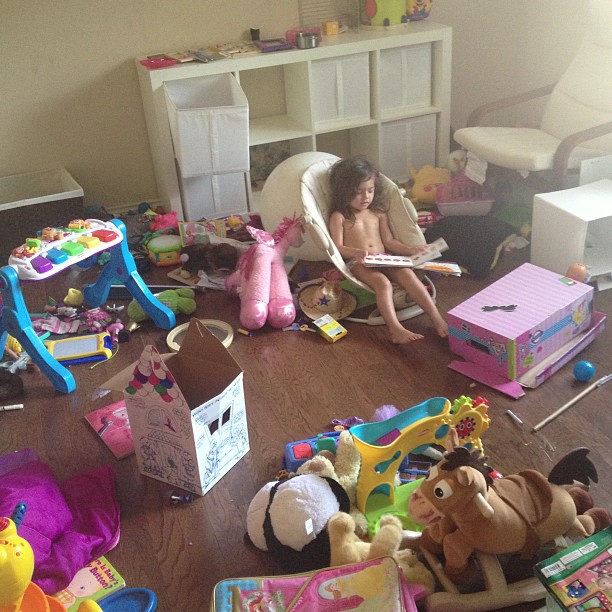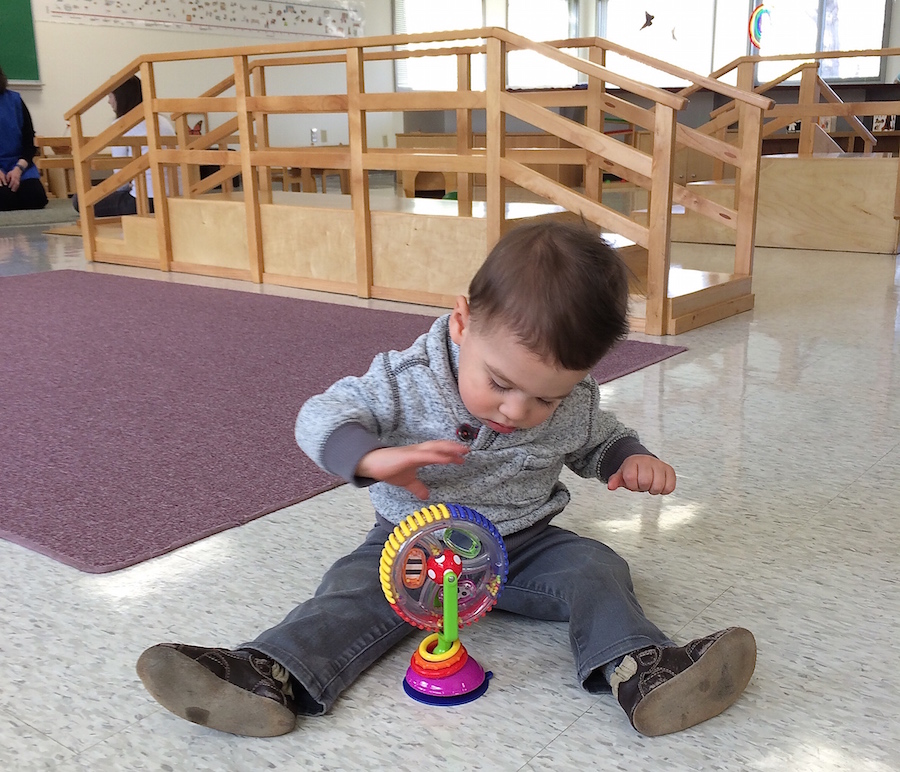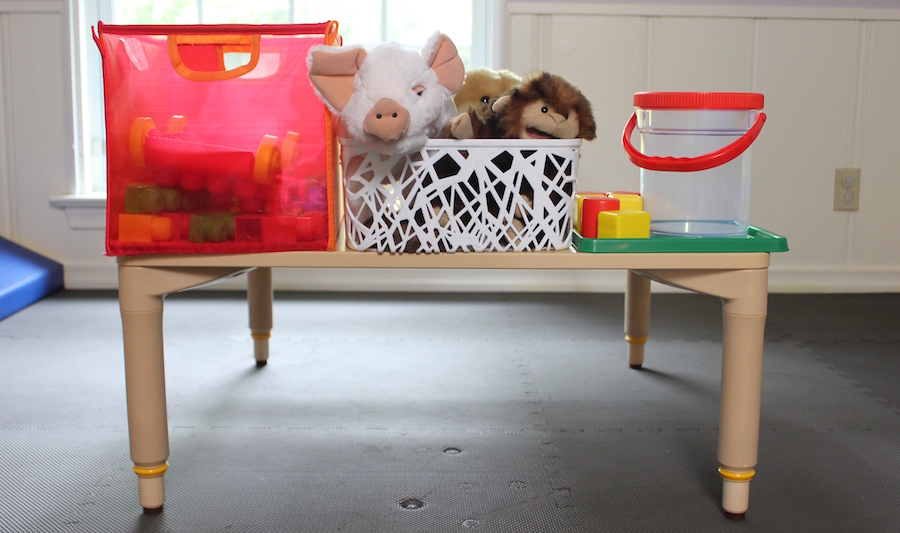Recently I shared why I got rid of my wardrobe. But long before I tackled my closet, I took on the toys. I vowed there would be no more stepping on Legos in the middle of the night and tripping over blocks. Too many toys are a safety hazard and a sanity hazard.
I have to argue that any child would be completely overwhelmed with a selection of toys as lengthy as the Cheesecake Factory Menu. Just like I felt about my wardrobe, I believe maintaining a short “fine-dining” menu of higher quality, carefully chosen toys is a better fit for children.

So I knew what I didn’t want: toy chaos. What I did want was a tranquil space for my son to play independently. After all, we know kids learn through play. So I pictured his playroom to be like his office. The place were the real work (a.k.a playing) gets done.
We started to learn about a child’s “work” when we enrolled Nicolas in a playgroup in our neighborhood. It was at a Montessori school–which we didn’t know a thing about. The first week, my husband David took him to the group. David came back from the group with an excited but confused mix of feelings. He explained to me that the classroom felt empty–maybe even a little boring.
David told me everything in the classroom had its place. Each toy in the classroom had its own little basket and a special spot on the shelf. And the rule was that each child should only play with one toy at a time, and put it away when they are done. Groundbreaking, right? What’s more, he said that all of the kids were completely engaged in the few toys the room had to offer. There was no mischief-making…no one trying to unload the teacher’s cupboards, bite their friends, or run out of the room. I was intrigued.

The following week I observed it myself for the first time. After my first observation, I was sure that the school was lacing the Kool-Aid with a special rule-following medication. Either that or it was a cult. I couldn’t get over how well the children played independently. They were completely absorbed and occupied in their tasks at hand. I was determined to figure out what the secret was so I could jump on the bandwagon and bring it home.
I started to read a little more on the school’s philosophy behind their seemingly minimalist classrooms. I quickly came across a blog post entitled “There’s just too much stuff.” It resonated with me because, like most of America, we.just.have.too.much.stuff. I found out the answer to my problem was having fewer toys, and picking the right toys. To quote the author:
The things we surround ourselves with are not always lovely, not always useful or meaningful. In our house, we have closets and a garage full of things we don’t really need or use. We have living spaces that are cluttered with toys, books, games, art projects and the like. Often these things have missing or broken pieces…What I will do is be more deliberate about what we really need, what is truly engaging, and what is lovely and pleasing to us. I intend to be more thoughtful in how these things are arranged, displayed and organized. Nothing is stacked or hidden, nothing is in a toy box or in cluttered bins. The children can see the materials, can access them easily, and can put them away with ease.
And with that quote, I was sold. Hook, line, and sinker.

We created our son’s office playroom in a way that we hope he will be learning and playing in for years to come. Is it extreme? Yes, absolutely. But we have already seen how wonderful it has been for his play, development, and sanity (heck, mostly our sanity). Here’s how we did it.
1. We started with a completely bare space. Starting with an empty play room allowed us to add each item in one-by-one with careful consideration.
2. We got the right organizers. Toy boxes and large bins are a bottomless pit that invite dumping. Instead, we have trays and short (6 inches) containers that can easily be accessed without mess making. These types of storage containers ensure that the items are easy to see, easy to access, and contained.


3. We found a toy-style. Just like people have different clothing styles, there are also different toy styles. This grandma’s toy-style really stuck with me.
Several years ago, I was trying to find a hobbyhorse, the kind that has a horse’s head on a stick, for my youngest granddaughter who had fallen in love with all things horsey. Much to my surprise, I could never find one that didn’t make all sorts of horse sounds and play cowboy songs — we quickly removed the batteries. A silent horse allowed her to create her own sounds and stories.
Our toy-style includes mostly toys that are task-based (a shape sorter, a puzzle—generally toys that you can “complete” or master). We also try to incorporate many open-ended toys, much like the silent horse.

Although it may be controversial, we request “no gifts” at birthday parties. Our close family and friends spend time with him and are familiar with our toy-style. They tend to purchase great additions to his space. If we do receive a gift thats not “our style”, we try to repurpose it or donate it to a good cause. If someone gifted me some jeans that were clearly too small or weren’t my style, it is unlikely to would wear them. I don’t think the use of toys should be much different.
4. We changed how we buy toys. Rather than sticking to the birthdays and holidays to buy toys, I buy them year around. We have a “one-in-one out” policy, with 15 toys and 8 books in the playroom at any given time. I buy toys used as much as possible. And when he outgrows them, I put them into storage for our future children.
I don’t get sucked in to things that “look super fun”. I buy toys all year to meet his developmental needs and interests-which are always changing. Once he masters the chunky shape puzzles, it’s time to move onto the jigsaw. Keeping the toys appropriate for his current age keeps him engaged. If the room was filled with toys that were too baby-ish or too mature, he would either ignore them or play with them inappropriately.
5. We keep variety. I always make sure to keep at least one of each of following types of toys: Gross motor, fine motor, plush, stacking, building, connecting, puzzles, pretend play, musical play, art play, and of course books–the books are rotated regularly.
6. We keep it minimal. I rarely put out an entire set of anything. Does he really need access to all 300 Mega Blocks that came in the set? No. Usually 50 will do the job. And he only needs one Thomas the Tank Engine. He does not need Birthday Thomas, Musical Thomas, Light-up Thomas, AND Halloween Thomas. Setting boundaries helps to free up space in the room and makes for easy clean up.
Speaking of clean up…it’s so easy. If I do it myself after bedtime it takes me 1 minute and 20 seconds (yes, I timed it) to put everything back in perfect working order. If Nicolas helps, it obviously takes a bit longer. It’s not always clean. And he doesn’t always (or even usually) put away the toys as he plays. But I feel good about where we are at right now.

I don’t want to spend the next decade yelling at my kids to clean up their toys. If the toys are manageable they will not only be easier to clean up, but easier to get out and enjoy.
And he does enjoy them. Nicolas is an incredibly happy, busy little man. I feel confident that these toys provide him with a lot of fun and numerous opportunities of exploration and creativity.
What do you think of our toy philosophy? I know it will get challenging as he gets older. And even more challenging as we think about adding more children to our family.
Do you think you could make something similar work in your house?
This Dallas Moms Blog original post was featured on August 13, 2015 by The Today Show. We’re proud of our website and the amazing expertise all of our contributors bring to this collaborative website! You can see the video here:
[xyz-ihs snippet=”Today-Show–Rid-of-Toys”]














I love your philosophy. I try to do this with three kids but I have such a hard time figuring out what is appropriate for what age (I was an engineering major, I don’t know about development!). Where did you get your trays?
As a grandmom I’m only in charge of toys in my house. Granddaughter doesn’t play a lot with toys preferring creative endeavors. However when I asked her if something was a baby toys and maybe we should donate it she assured me she still wanted to play with certain toys. Not sure how much is OCD or putting too much responsibility on her. I would like to downsize her toys but don’t know what to do.
Also I can’t figure out if I should biy her new toys of any sort for her upcoming birthdsy. She will be seven.
this is very interesting! Do you do bath toys? My son LOVES the bath (he is 11 months).
Mine love bath toys. I hate bath toys. Solution? They can have whatever they can cram into this thing: http://www.booninc.com/products/frog-pod
They’re allowed to rotate, but no more than that at any one time.
Really loved your approach here. I just got my preschooler’s toys 80% organized and need to purge and/or store some of the more useful stuff for little man #2 coming in November until he is ready (we have a big barn we use). I actually organize for a living which is the hilarious part (I am like the contractor whose house doesn’t get the remodel attention). My problem now is communicating to the grandparents this year to please keep the gifts to down to experiential, clothing, or learning related items. In particular, I cannot handle anymore large playsets taking up space on the floor anymore or as disassembled piles of junk. I have already donated tons of stuff over the years (I have no issues getting rid of things), but it’s just the accumulation and tired avoidance I need to jump on to keep the consumerist explosion down. I am reinspired! Thanks!
Great article. I never thought of it as a “toy style” but we’ve been doing much the same for many years. My son went to a Montessori school from age 2 through grade 5. And we applied a lot of the theories at home as well. We ended up buying a number of furniture and toys from Michael Olaf over the years. We particularly used this bookshelf for a long time. http://michaelolaf.com/store/product427.html As for handling the grandparents that insisted on buying presents – I kept an Amazon wish list with appropriate toys. Usually things for the next stage of development.
I absolutely loved this post. I read a lot about minimalism and how to take a minimalist approach in parenting but I wish all these concepts were introduced to me a few years ago. In some aspects, like toys, I’ve already done so much wrong! My kids are 5 & 3 and have lots of toys – enough to get them confused about what to play with, and also transforming our house into a post-apocalipse scene. And that’s basically all my fault, since the majority of toys were bought by me without even thinking about their real usefulness.
I’ve donated lots of things and also started rotating toys – they just adore that – it reduced the clutter but it’s still too much. I already started thinking about ways to avoid birthday presents this year without having to avoid the party – my older child is kind of starting to know about charities and I’ll probably suggest that the kids make donations instead of buying presents. I’m really hopeful she’ll like the idea, let’s see. Anyway, yesterday they did such a mess with the toys and wouldn’t help me tidy up and I told them that they wouldn’t have any birthday present to add to the clutter – they agreed. I know they only did because they didn’t want to tidy up, but I also know they got the idea.
Some great ideas, and although I am all in favour of task based toys imaginative play is so important. If it were my child’s room I would have a dress up box, old sheets for making cubbies, and art materials. The Montessori system is great but can be very prescriptive I would have to include a bit of the Steiner philosophy in there too.
But as for having fewer commercial toys I think you have done a wonderful thing.
I
Good Luck with it all.
For everyone interested in what a Montessori-inspired kid’s home looks like beyond the playroom, I suggest http://elternvommars.blogspot.de/?m=1
It’s in Austrian, but I guess the pics speak for themselves.
There’s no such thing as Austrian!! You might mean German.
this is fine if you have 1 kid like you do. Multiple kids at different ages makes this not very doable. I like them having more variety, free play area, and art area too. Limiting books is not a great idea either. The concept is good but I’m not super impressed with his post.
I have multiple ages too. The way I can tell if we’ve got too much is if they can’t play and also clean up and maintain their toys and play areas. If they’re leaving messes and overwhelmed it is too much.
First of all, i have to say thanks for the post, this is such an inspiration! I would really like to try it. Your little guy might be a bit young for this, but I’m curious how you deal with art supplies? Do you limit/rotate those as well or do they get separate treatment since they will eventually get used up?
I started by introducing mine to one type of art medium at a time, and different varieties each time until they started requesting their choices and eventually growing old enough to get them out on their own. Have fun!